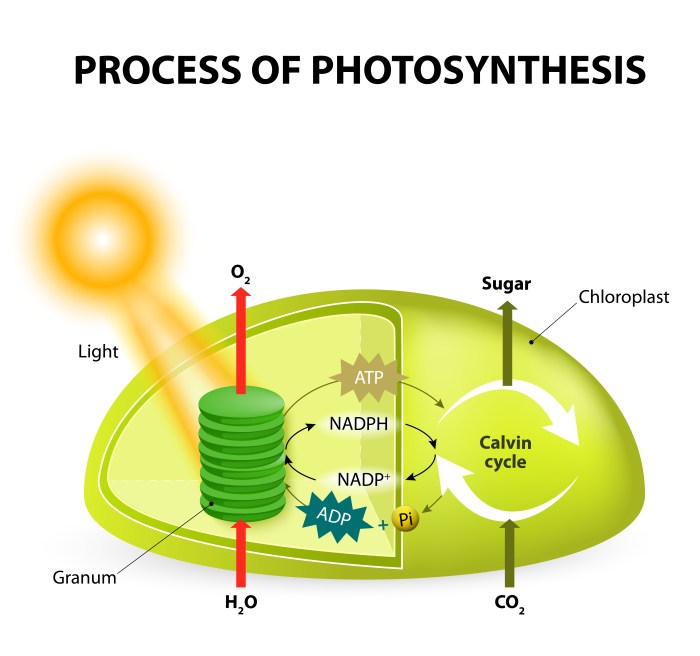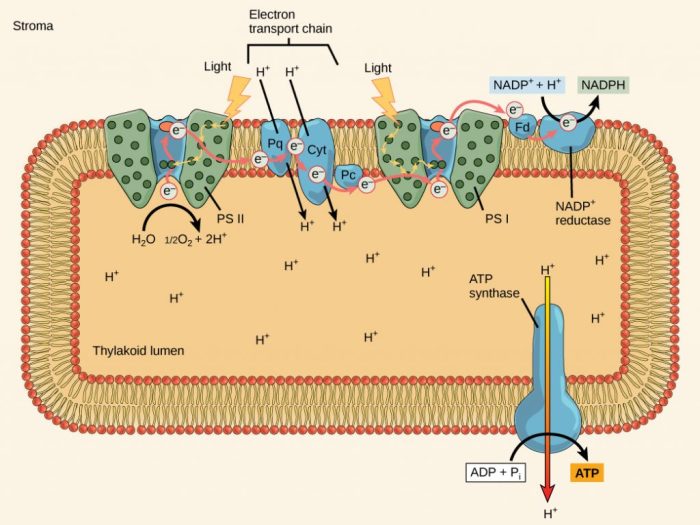Do Plants Need Water for Photosynthesis?
The Crucial Role of Water in Photosynthesis
Do plants need water for photosynthesis – Photosynthesis, the process by which plants convert light energy into chemical energy, is fundamentally dependent on water. This process, vital for plant life and the global ecosystem, relies on water not just as a solvent, but as an active participant in the complex biochemical reactions involved.
Water’s Role as a Reactant in Photosynthesis
The overall chemical equation for photosynthesis illustrates water’s critical role: 6CO 2 + 6H 2O + Light Energy → C 6H 12O 6 + 6O 2. This equation shows that water (H 2O) is a reactant, alongside carbon dioxide (CO 2), necessary for the production of glucose (C 6H 12O 6), the plant’s primary energy source, and oxygen (O 2) as a byproduct.
Water’s Function in the Light-Dependent Reactions

Source: co.uk
Water’s specific function is primarily within the light-dependent reactions of photosynthesis, which occur in the thylakoid membranes of chloroplasts. During this stage, water molecules undergo photolysis, a process where light energy splits water molecules into oxygen, protons (H+), and electrons.
While water is crucial for photosynthesis in most plants, the process isn’t quite as straightforward for all species. Understanding the role of water in photosynthesis helps us appreciate the unique watering needs of different plants, such as air plants; learning how to properly hydrate them is key, and you can find helpful guidance on how do you water air plants.
Ultimately, the specific water requirements directly impact a plant’s ability to conduct photosynthesis effectively.
- The oxygen is released as a byproduct.
- The protons contribute to the proton gradient across the thylakoid membrane, driving ATP synthesis.
- The electrons are passed along the electron transport chain, ultimately contributing to the reduction of NADP+ to NADPH.
Water’s Contribution to ATP and NADPH Production
The process is a series of redox reactions. Photolysis of water provides the electrons that replace those lost by chlorophyll during the excitation process. The electron flow through the electron transport chain generates a proton gradient across the thylakoid membrane. This gradient drives ATP synthase, producing ATP (adenosine triphosphate), the primary energy currency of the cell. Simultaneously, NADP+ is reduced to NADPH using electrons from the electron transport chain, serving as a reducing agent in the subsequent light-independent reactions.
Photosynthesis Under Water Stress
When plants experience water stress (water deficiency), their photosynthetic rate decreases significantly. Insufficient water reduces the rate of photolysis, limiting the supply of electrons for the electron transport chain. This leads to a decrease in ATP and NADPH production, hindering both light-dependent and light-independent reactions. Stomata close to conserve water, reducing CO 2 uptake, further impacting photosynthesis.
Water Movement During Photosynthesis: A Flowchart

Source: pressbooks.pub
Water travels from the roots to the leaves through a process called transpiration. This is driven by the cohesive and adhesive properties of water molecules and the transpiration pull generated by evaporation from leaves.
- Water absorption by roots via osmosis.
- Water transport through xylem vessels.
- Water reaching leaves through leaf veins.
- Water used in photolysis in chloroplasts.
- Water loss through transpiration from stomata.
Water Transport and Photosynthesis Efficiency
Efficient water transport is crucial for maintaining optimal photosynthetic rates. Several mechanisms and factors influence this relationship, impacting overall plant productivity.
Water Absorption and Transport Mechanisms
Plants absorb water primarily through their roots via osmosis. The water then moves upwards through the xylem vessels, a specialized vascular tissue, to the leaves. This upward movement is driven by the transpiration pull, the cohesive forces between water molecules, and the adhesive forces between water and the xylem walls.
Water Stress and Stomatal Function
Water stress significantly impacts stomatal function. Stomata, tiny pores on the leaf surface, regulate gas exchange (CO 2 uptake and O 2 release). Under water stress, stomata close to minimize water loss through transpiration. However, this closure also restricts CO 2 entry, reducing the rate of photosynthesis.
Water Potential and Photosynthetic Rate
Water potential, the tendency of water to move from one area to another, is directly related to photosynthetic rate. Higher water potential (more readily available water) leads to higher photosynthetic rates. Conversely, lower water potential (water stress) results in reduced photosynthetic activity.
Environmental Factors Influencing Water Availability
Several environmental factors affect water availability for photosynthesis, including rainfall, temperature, humidity, and soil type. Drought conditions, high temperatures, and low humidity can all lead to water stress, negatively impacting photosynthesis.
Photosynthetic Efficiency Under Varying Water Conditions, Do plants need water for photosynthesis
Different plant species exhibit varying degrees of tolerance to water stress. Some plants are adapted to arid environments and can maintain relatively high photosynthetic rates even under water-limited conditions. Others are more sensitive and experience significant reductions in photosynthesis under drought.
| Plant Species | Water Condition | Photosynthetic Rate (µmol CO2 m-2 s-1) | Stomatal Conductance (mmol H2O m-2 s-1) |
|---|---|---|---|
| C3 Plant (e.g., Wheat) | Well-watered | 20-25 | 0.3-0.4 |
| C3 Plant (e.g., Wheat) | Water-stressed | 5-10 | 0.05-0.1 |
| CAM Plant (e.g., Cactus) | Well-watered | 5-10 | 0.05-0.1 |
| CAM Plant (e.g., Cactus) | Water-stressed | 3-5 | 0.01-0.05 |
Photosynthesis Without Water: A Hypothetical Scenario
Complete water deprivation would have catastrophic consequences for plant photosynthesis. Understanding plant responses to drought is crucial for developing drought-resistant crops.
Consequences of Complete Water Deprivation
Without water, photolysis cannot occur, halting electron flow in the electron transport chain. ATP and NADPH production ceases, effectively shutting down both the light-dependent and light-independent reactions of photosynthesis. The plant would be unable to produce glucose, its primary energy source, leading to cell death.
Plant Responses to Drought
Plants employ various strategies to cope with drought. These include reducing transpiration by closing stomata, shedding leaves, and developing deeper root systems to access groundwater. Some plants store water in succulent tissues. Metabolic adjustments involve shifting to alternative metabolic pathways to conserve energy and water.
Metabolic Pathways Under Water Stress
Under water stress, plants may activate alternative metabolic pathways such as CAM (Crassulacean Acid Metabolism) or C4 photosynthesis, which are more water-efficient than the typical C3 pathway. These pathways minimize photorespiration and enhance CO 2 fixation under water-limited conditions.
Examples of Plants Adapted to Arid Environments
Many plants have evolved remarkable adaptations to survive in arid environments. Cacti, for example, store water in their stems and have reduced leaf surfaces to minimize water loss. Some desert plants have deep root systems to access groundwater, while others have specialized leaf structures to reduce transpiration.
A Hypothetical Experiment on Water Levels and Photosynthetic Output
An experiment could involve growing a specific plant species (e.g., Arabidopsis thaliana) under controlled conditions with varying levels of water availability. Photosynthetic rates could be measured using gas exchange systems, comparing plants under well-watered, moderately stressed, and severely stressed conditions. Measurements of chlorophyll content and stomatal conductance could also provide valuable insights.
Water and Photosynthetic Pigments
Water availability plays a crucial role in the production, stability, and function of photosynthetic pigments, impacting light absorption and photosynthetic efficiency.
Water’s Influence on Chlorophyll Production and Function
Water is essential for the synthesis of chlorophyll, the primary photosynthetic pigment. Water stress can inhibit chlorophyll synthesis, leading to a reduction in chlorophyll content and a decrease in light absorption capacity. Furthermore, water is crucial for maintaining the proper three-dimensional structure of chlorophyll molecules, which is essential for their function in light absorption and energy transfer.
Water Stress and Light Absorption/Reflection
Water stress can alter the structure and organization of chloroplasts and thylakoid membranes, impacting light absorption and reflection by plant leaves. Under severe water stress, leaves may become thicker and reflect more light, reducing the amount of light energy available for photosynthesis.
Changes in Pigment Concentration and Photosynthesis Rate
A reduction in chlorophyll concentration due to water stress directly correlates with a decrease in the rate of photosynthesis. Less chlorophyll means less light absorption, resulting in reduced ATP and NADPH production and a lower rate of carbon fixation.
Chlorophyll Spectral Properties Under Different Hydration Levels
The spectral properties of chlorophyll (its absorption and emission of light at different wavelengths) can be affected by hydration levels. Dehydration may lead to changes in the absorption peaks and overall efficiency of light capture by chlorophyll molecules.
Molecular Structure of Chlorophyll and Water Interaction
Chlorophyll molecules have a porphyrin ring structure with a magnesium ion at the center. Water molecules can interact with the chlorophyll molecule through hydrogen bonding, influencing its conformation and potentially its interaction with other molecules involved in the photosynthetic process. A detailed description would show the planar porphyrin ring, the hydrophobic phytol tail, and the locations where water molecules could potentially form hydrogen bonds with various functional groups on the molecule.
Frequently Asked Questions: Do Plants Need Water For Photosynthesis
What happens if a plant doesn’t get enough water?
Water stress leads to reduced stomatal opening, limiting CO2 uptake and thus decreasing the rate of photosynthesis. Plants may also exhibit wilting, reduced growth, and even death.
Can plants photosynthesize in the dark?
No, photosynthesis requires sunlight as the energy source to drive the process.
How does the type of plant affect its water needs for photosynthesis?
Different plants have varying adaptations to water availability. Xerophytes, for example, are adapted to arid environments and have mechanisms to conserve water, while hydrophytes thrive in aquatic environments.
What is the role of water in the production of oxygen during photosynthesis?
Water molecules are split during the light-dependent reactions, releasing oxygen as a byproduct.





















